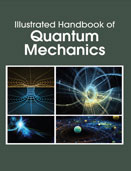Handbooks

Quantum mechanics is a theory of matter that is based on the concept of the possession of wave properties by elementary particles, that affords a mathematical interpretation of the structure and interactions of matter on the basis of these properties, and that incorporates within it quantum theory and the uncertainty principle. This illustrated handbook provides a carefully structured and complete exposition of quantum mechanics and illustrates the common threads linking many different phenomena and subfields of physics.
to describe and account for the properties of molecules and atoms and their constituents?electrons, protons, neutrons, and other more esoteric particles such as quarks and gluons. It results in what may appear to be some very strange conclusions about the physical world. At the scale of atoms and electrons, many of the equations of classical mechanics, which describe how things move at everyday sizes and speeds, cease to be useful. In classical mechanics, objects exist in a specific place at a specific time. However, in quantum mechanics, objects instead exist in a haze of probability; they have a certain chance of being at point A, another chance of being at point B and so on.
Illustrated Handbook of Quantum Mechanics gives a solid understanding of the basic concepts and results of quantum mechanics including the historical background and philosophical interrogations. The field of quantum mechanics has been enormously successful in explaining many of the features of our world. The behavior of the subatomic particles (electrons, protons, neutrons, photons, and others) that make up all forms of matter can often be satisfactorily described only using quantum mechanics. Quantum mechanics has also strongly influenced string theory. The implications of quantum theory are wide ranging. Quantum mechanics has explained the structure of the atom and the structure of the nucleus. Without knowing the structure of the atom, most of the physics and chemistry that we know today wouldn?t have been possible. Quantum theory predicted the existence of antimatter, and explains radioactivity. Many applications resulting from quantum theory are in use today, and its applications in the future are potentially infinite. Quantum mechanics is also critically important for understanding how individual atoms combine covalently to form molecules. Quantum mechanics can also provide quantitative insight into ionic and covalent bonding processes by explicitly showing which molecules are energetically favorable to which other molecules and the magnitudes of the energies involved. Furthermore, most of the calculations performed in modern computational chemistry rely on quantum mechanics. A great number of modern technological inventions operate on a scale where quantum effects are significant. Examples include the laser, the transistor, the electron microscope, and magnetic resonance imaging (MRI). The study of semiconductors led to the invention of the diode and the transistor, which are indispensable parts of modern electronic systems and devices. The theory of relativity describes the behavior of large everyday objects in the world around us. However this theory alone is not enough to describe things at a very small scale. At the level of atoms and sub-atomic particles objects behave very differently and quantum theory is an attempt to describe the behavior of matter and energy at this sub atomic scale.
Illustrated Handbook of Quantum Mechanics gives a comprehensive introduction to the fundamental postulates and the mathematical formalism of quantum mechanics. This Handbook serves as a text for students and researchers to modern applications in engineering, physics, and nanotechnology.